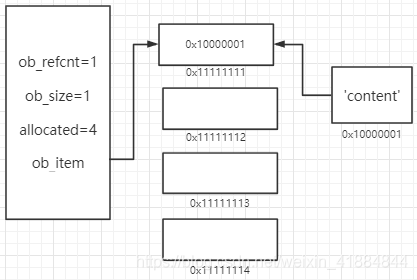Python源碼解析之List
創(chuàng)建列表C語言底層的結(jié)構(gòu)體
lists = []list.append(’name’)list.append(’age’)list.append(’grade’)
typedef struct{struct _object *_ob_next;struct _object *_ob_prev; // python內(nèi)部將對(duì)象放在鏈表進(jìn)行內(nèi)存管理Py_ssize_t ob_refcnt;// 引用計(jì)數(shù)器,就是多少變量用了它PyObject **ob_item;// 指針的指針,存列表的元素Py_ssize_t ob_size;// 已有元素個(gè)數(shù)Py_ssize_t allocated;// 列表容量,可容納個(gè)數(shù)} PyListObject;
c源碼來自 listobject.c
二、創(chuàng)建列表name_list = [ ]
PyObject *PyList_New(Py_ssize_t size){ PyListObject *op; size_t nbytes;#ifdef SHOW_ALLOC_COUNT static int initialized = 0; if (!initialized) {Py_AtExit(show_alloc);initialized = 1; }#endif // 緩存機(jī)制 if (size < 0) {PyErr_BadInternalCall();return NULL; } /* Check for overflow without an actual overflow, * which can cause compiler to optimise out */ if ((size_t)size > PY_SIZE_MAX / sizeof(PyObject *))return PyErr_NoMemory(); nbytes = size * sizeof(PyObject *); if (numfree) {numfree--;op = free_list[numfree];_Py_NewReference((PyObject *)op);#ifdef SHOW_ALLOC_COUNTcount_reuse++;#endif } else {op = PyObject_GC_New(PyListObject, &PyList_Type);if (op == NULL) return NULL;Py#ifdef SHOW_ALLOC_COUNTcount_alloc++;#endif } if (size <= 0)op->ob_item = NULL; else {op->ob_item = (PyObject **) PyMem_MALLOC(nbytes);if (op->ob_item == NULL) { Py_DECREF(op); return PyErr_NoMemory();}memset(op->ob_item, 0, nbytes); } Py_SIZE(op) = size; // 元素個(gè)數(shù) op->allocated = size; // 容量 _PyObject_GC_TRACK(op); //放到雙向鏈表進(jìn)行維護(hù) return (PyObject *) op; //返回列表的指針}三、添加元素
list中插入一個(gè)元素時(shí),擴(kuò)容連續(xù)的內(nèi)存地址(容量),在內(nèi)存創(chuàng)建需要插入的內(nèi)容p,將地址*p放入list的空間中,所以,PyListObject的ob_item是指針的指針

擴(kuò)容的曲線一般就是0,4,8,16,24…
// 添加元素static intapp1(PyListObject *self, PyObject *v){ // 獲取實(shí)際元素個(gè)數(shù) Py_ssize_t n = PyList_GET_SIZE(self); assert (v != NULL); if (n == PY_SSIZE_T_MAX) {PyErr_SetString(PyExc_OverflowError, 'cannot add more objects to list');return -1; } // 計(jì)算當(dāng)前容量和內(nèi)部元素個(gè)數(shù) // 直接添加元素/擴(kuò)容添加 if (list_resize(self, n+1) == -1)return -1; // 將元素添加到ob_item,v Py_INCREF(v); PyList_SET_ITEM(self, n, v); return 0;} 擴(kuò)容
// 擴(kuò)容機(jī)制 // newsize: 已存在元素個(gè)數(shù)+1static intlist_resize(PyListObject *self, Py_ssize_t newsize){ PyObject **items; size_t new_allocated; Py_ssize_t allocated = self->allocated; // 當(dāng)前的容量 // 1,容量大于個(gè)數(shù) // 2,個(gè)數(shù)大于容量的一半(容量足夠且沒有內(nèi)存浪費(fèi)) if (allocated >= newsize && newsize >= (allocated >> 1)) {assert(self->ob_item != NULL || newsize == 0);Py_SIZE(self) = newsize;return 0; } /* * The growth pattern is: 0, 4, 8, 16, 25, 35, 46, 58, 72, 88, ... */ // 擴(kuò)容機(jī)制的算法 new_allocated = (newsize >> 3) + (newsize < 9 ? 3 : 6); /* check for integer overflow */ if (new_allocated > PY_SIZE_MAX - newsize) {PyErr_NoMemory();return -1; } else {new_allocated += newsize; } if (newsize == 0)new_allocated = 0; // 擴(kuò)容/縮容(涉及原來元素的遷移) items = self->ob_item; if (new_allocated <= (PY_SIZE_MAX / sizeof(PyObject *)))PyMem_RESIZE(items, PyObject *, new_allocated); elseitems = NULL; if (items == NULL) {PyErr_NoMemory();return -1; } // 賦值,更新個(gè)數(shù)和容量 self->ob_item = items; Py_SIZE(self) = newsize; self->allocated = new_allocated; return 0;}四、移除元素
list.pop()刪除最后一個(gè)元素只需要修改size,不需要清除數(shù)據(jù),下次append可以直接覆蓋這個(gè)位置指定索引位置移除后,向前補(bǔ)位
static PyObject *listpop(PyListObject *self, PyObject *args){ Py_ssize_t i = -1; PyObject *v; int status; if (!PyArg_ParseTuple(args, '|n:pop', &i))return NULL; if (Py_SIZE(self) == 0) {/* Special-case most common failure cause */PyErr_SetString(PyExc_IndexError, 'pop from empty list');return NULL; } if (i < 0)i += Py_SIZE(self); if (i < 0 || i >= Py_SIZE(self)) {PyErr_SetString(PyExc_IndexError, 'pop index out of range');return NULL; } v = self->ob_item[i]; // 刪除最后一個(gè),僅改變size if (i == Py_SIZE(self) - 1) {status = list_resize(self, Py_SIZE(self) - 1);assert(status >= 0);return v; /* and v now owns the reference the list had */ } Py_INCREF(v); // 不是最后一個(gè),需要移動(dòng)數(shù)據(jù)位置 status = list_ass_slice(self, i, i+1, (PyObject *)NULL); assert(status >= 0); /* Use status, so that in a release build compilers don’t * complain about the unused name. */ (void) status; return v;}五、清空
list.clear()
static intlist_clear(PyListObject *a){ Py_ssize_t i; PyObject **item = a->ob_item; if (item != NULL) {i = Py_SIZE(a);// 各個(gè)元素設(shè)置為空Py_SIZE(a) = 0;a->ob_item = NULL;a->allocated = 0;// 引用計(jì)數(shù)器-1while (--i >= 0) { Py_XDECREF(item[i]);}PyMem_FREE(item); } return 0;}六、銷毀
del list
銷毀列表對(duì)象的操作將列表的引用計(jì)數(shù)-1引用計(jì)數(shù)>0,還有應(yīng)用的話不做操作引用計(jì)數(shù)=0,沒人使用
處理列表的元素,將所有引用計(jì)數(shù)-1(GC回收0計(jì)數(shù)) ob_item=0,ob_size=0,ob_allocated=0 將列表從雙向鏈表移除,可以銷毀 為了提高效率,Python結(jié)束期在內(nèi)部為free_list緩存80個(gè)list,存放無使用的list,再創(chuàng)建的時(shí)候直接從緩存中拿來初始化。如果已經(jīng)存了80個(gè),del 的時(shí)候直接在內(nèi)存中銷毀對(duì)象static voidlist_dealloc(PyListObject *op){ Py_ssize_t i; // 判斷引用計(jì)數(shù)是否為0 PyObject_GC_UnTrack(op); Py_TRASHCAN_SAFE_BEGIN(op) if (op->ob_item != NULL) {i = Py_SIZE(op);while (--i >= 0) { Py_XDECREF(op->ob_item[i]);}PyMem_FREE(op->ob_item); } // free_list沒有80個(gè)的話緩存這個(gè)list if (numfree < PyList_MAXFREELIST && PyList_CheckExact(op))free_list[numfree++] = op; elsePy_TYPE(op)->tp_free((PyObject *)op); Py_TRASHCAN_SAFE_END(op)}
就是說創(chuàng)建列表時(shí),實(shí)際上不會(huì)直接開辟內(nèi)存,而是先看看free_list
# 兩次list的地址相同>>> list1=[1,2,3]>>> id(list1)69070216L>>> del list1>>> list2=[0,0,0]>>> id(list2)69303304L>>>
到此這篇關(guān)于Python源碼解析之List的文章就介紹到這了,更多相關(guān)Python List內(nèi)容請(qǐng)搜索好吧啦網(wǎng)以前的文章或繼續(xù)瀏覽下面的相關(guān)文章希望大家以后多多支持好吧啦網(wǎng)!
相關(guān)文章:
1. Warning: require(): open_basedir restriction in effect,目錄配置open_basedir報(bào)錯(cuò)問題分析2. ASP.NET Core 5.0中的Host.CreateDefaultBuilder執(zhí)行過程解析3. ASP調(diào)用WebService轉(zhuǎn)化成JSON數(shù)據(jù),附j(luò)son.min.asp4. SharePoint Server 2019新特性介紹5. ASP中常用的22個(gè)FSO文件操作函數(shù)整理6. React+umi+typeScript創(chuàng)建項(xiàng)目的過程7. php網(wǎng)絡(luò)安全中命令執(zhí)行漏洞的產(chǎn)生及本質(zhì)探究8. 無線標(biāo)記語言(WML)基礎(chǔ)之WMLScript 基礎(chǔ)第1/2頁9. 三個(gè)不常見的 HTML5 實(shí)用新特性簡(jiǎn)介10. php測(cè)試程序運(yùn)行速度和頁面執(zhí)行速度的代碼

 網(wǎng)公網(wǎng)安備
網(wǎng)公網(wǎng)安備